
Armor in the Indian subcontinent was used since antiquity. Its earlier reference is found in the Vedic period. [1] Armor has been described in religious texts; including the Itihasa epics Ramayana and Mahabharat, as well as in the Puranas.

Armor in the Indian subcontinent was used since antiquity. Its earlier reference is found in the Vedic period. [1] Armor has been described in religious texts; including the Itihasa epics Ramayana and Mahabharat, as well as in the Puranas.

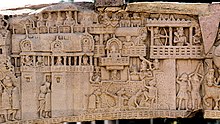


The Vedic age recorded in-fighting among Indian clans for supremacy over the Indus. In the Battle of the Ten Kings prominent Vedic clans clashed along the Ravi River. The Vedas and the other texts of the period record these struggles in detail and provide a clear picture of the military set up of during those periods.
The concept of a warrior class had already gained ground and the kshatriya claimed to have originated from the arms of Purusha. They tried to maintain this distinct identity of their own through their garments and attire. The common attire (when they are not situated at the battlefield) for the kshatriya warrior was deer skin. Their under-garments were made cloak dyed with Indian maddar. They also wore hemp thread and a bow string as a mark of distinction.
Armour was prominently mentioned in the Rigveda:
The warrior's look is like a thunderous rain-cloud's, when, armed with mail, he seeks the lap of battle. Be thou victorious with unwounded body: so let the thickness of thy mail protect thee...Thy vital parts I cover with thine armour: with immortality...clothe thee...
— Rig Veda, tr. by Ralph T.H. Griffith, [1896], HYMN LXXV. Weapons of War.
The defensive armors became the integral part of military costume. They were worn after duly sanctified by mantras. It appears that they were used only by the nobility. The average soldier wore deer skin, and is mentioned in the Atharvaveda, stating that the shield and outfit made of deer skin struck terror amid the enemies of god. The nobles and elite warriors wore a coat of mail called a drapi, kavacha, or varman. They covered their back, chest, and lower parts of their body.
Certain warriors in the Vedic period wore metal armour called varman. In the Rig Veda the varman is described as sewn armor or a coat of mail that covers the whole body.
Agni, the man who giveth guerdon to the priests, like well-sewn armour thou guardest on every side.
— The Rig Veda/Mandala 1/Hymn 31
Historians such as Edward Washburn Hopkins deduce that the armour was metal that covered the body and was connected by wires. On the head multiple metal pieces were connected together for helmets. [1]
The kavacha is described to be plate armour and tightly fitted, and covered the chest. The word kavaca is used in Atharva Veda in the sense of a corselet breast plate as opposed to the varman:
...warrior, mailed, unmailed, each foeman in the rush of war. Down-smitten with the strings of bows, the fastenings of mail, the charge! The armour-clad, the armourless, enemies clothed with coats of mail. All struck down...
— Artha Veda Book XI Hymn XXII
The use of helmets is frequently mentioned in the vedas. Shirastrana was a helmet or head guard worn by soldiers to protect the head. Siprin would mean a person wearing a helmet. Common soldiers would go bare headed, some kept long hairs and wore animal horns. Indra is described as the golden helmeted hero:
So be the lofty Indra prompt to listen, Helper unaided, golden-visored Hero.
— The Rig Veda/Mandala 6/Hymn 29
Hastaghna was and arm guard used to protect the hands. It was worn on the left arm to avoid friction of bow strings. It was made of leather but later on metal gauntlets seem to have used instead.
For the protection of the legs; greaves, anklets, and shoes were used. The noble warriors wore ornaments like armlets, bracelets, clasps, necklaces, and various garlands.
Description of armor was continued in the Upanishads.
Its priestly honorarium consists of a horse chariot pulled by four horses. The chariot is provided with golden plates, with a whip, with all sorts of ornaments and with splendour. Its deck is covered with tiger skin, its bow-case with panther skin, its quiver with bear skin. The warrior standing on it is equipped for battle, wearing armour made of rhinoceros skin; he has a charioteer equipped for battle, and is protected by the two side panels. The rein-holder wears a neck ornament and a garland.
— Jaiminīya-Brāhmaṇa
Armour is discussed in Chanakya's Arthashastra (320 BCE).
The Arthashastra extensively discusses various types of armors used in ancient India. These armors included Lohajālika, paṭṭa, kavaca, and sūtraka. Lohajālika, a type of mail armor made from iron or steel, is renowned for its exceptional durability, lightweight nature, and strength. In ancient Indian armories, Lohajālika was prevalent due to its lightweight properties and resilience against a variety of attacks, particularly those from bladed weapons such as swords and axes. The Lohajālika armor provided superior protection against slashing and piercing assaults. Additionally, these armors were crafted with intricate designs and often adorned with embellishments that reflected the craftsmanship and cultural aesthetics of the time. The use of iron and steel in armor-making not only enhanced the defensive capabilities of warriors but also showcased the advanced metallurgical skills present in ancient Indian civilization. In the Arthashastra, the Patta armor is described as a coat of iron, steel or animal skins with hoofs and horns of various animals like porpoise, rhinoceros, and bison without cover for the arms. One thing to Kavacha was plate armor that covered the chest, torso and other parts of the body, providing protection to warriors. It was tightly fitted and made of metal or leather, offering defense in battle. Sūtraka was a type of armor made of leather or iron. It covered only hips and the waist. Likewise śirāstrāṇa (cover for the head), kaṇṭhatrāṇa (cover for the neck), kūrpāsa (cover for trunk), kañcuka (a coat extending as far as the knee joints), vāravāṇa (a coat extending as far as the heels), paṭṭa (a coat without cover for the arms), and nāgodarikā (gloves) are the varieties of armour. Armour and Ornaments for elephants, chariots, and horses as well as goads and hooks to lead them in battlefields constitute accessory things (upakaraṇāni).
The Kingdom of Magadha rapidly expanded its military infrastructure under King Ajatashatru, creating the foundation of later empires in Pataliputra. He introduced the rathamusala, an armoured chariot with protruding blades.
The Bharhut Stupa depicts the use of leather scale armour. Furthermore, on the Sanchi Stupa, soldiers are depicted wearing quilted armour.
There are references by historians noting the armour King Porus used in battle against Alexander. The scholar Arrian recorded that the armour was shot-proof, and remarkably well fitted. [2]
In Mahabharata, there are much evidence of using armour during the battles.

During the Gupta period scale mail armour used as composed of metal and sometimes leather. Guptas were more than two centuries more advanced than the equipment and technology being depicted here and that their armour was built to withstand torsion-driven steel bows. Siva-Dhanur-Veda discusses the military of the Gupta Empire. The Guptas relied heavily on armoured war elephants; horses were used little if at all. The use of chariots had declined heavily by the time of the Guptas, as they had not proved very useful against the Greeks, Scythians, and other invaders. Guptas utilised heavy cavalry clad in mail armour and equipped with maces and lances, who would have used shock action to break the enemy line.
During the Satavahana period the armour was inspired by the armour used by the Indo-Scythians and the Alchon Huns.

During 12th century chainmail armour is first introduced in the Indian subcontinent and used by Turkic armies. A reference of chainmail armour was found in the inscription of Mularaja II and also at the Battle of Delhi [5] where it was used by the armoured war elephants. Udayaprabha Suri, in his Sukrita-Kirti-Kallolini, states that Naikidevi gave Mularaja an army to play with. With this army, Mularaja defeated the Hammira (Sanskrit form of Emir ) and his mlechchha army, whose soldiers were covered from head to toe in order to protect themselves. [6]
In the 16th century the armour in the Indian subcontinent incorporated plated embedded into mail. Armour such as chainmail and scale mail are widely used by the Mughals. The use of Mail and plate armour in india declined in the 18th century. Mail and plate armour was documented Battle of Plassey in 1757. [7]
Despite the similarity in their design, the Khula Khud helmets were decorated with a wide degree of variations depending on the cultures from which they were created. Decorations often appeared in the skull and the nasal bar, which were often heavily decorated with patterned motifs of inlaid brass, silver or gold; or decorated with figurative images. One Mughal top helmet featured calligraphic inscriptions from the Quran, supposedly to gain "Help from Allah and a speedy victory." A top discovered in Gwalior, India, featured a motif of the skull and crossbones sign of European influence. Another part of the Khula Khud helmet that was often a focus of artistic decoration, was the leaf-shaped finials of the nasal bar. A Sikh top featured the figure of Ganesha carved onto the nasal bar. The Khula Khud helmet was only decorated with some metals, and usually no organic decorations. [8]
Maratha armour is very similar to the Mughal armour but in the Maratha army, the infantry used armour while the cavalry is always lightly armoured, such as the leather armour. Maratha armour is mostly inspired by the Mughal armour.

Armour or armor is a covering used to protect an object, individual, or vehicle from physical injury or damage, especially direct contact weapons or projectiles during combat, or from a potentially dangerous environment or activity. Personal armour is used to protect soldiers and war animals. Vehicle armour is used on warships, armoured fighting vehicles, and some combat aircraft, mostly ground attack aircraft.

Chain mail is a type of armour consisting of small metal rings linked together in a pattern to form a mesh. It was in common military use between the 3rd century BC and the 16th century AD in Europe, while it continued to be used in Asia, Africa, and the Middle East as late as the 17th century. A coat of this armour is often called a hauberk or sometimes a byrnie.

A cuirass is a piece of armour that covers the torso, formed of one or more pieces of metal or other rigid material. The word probably originates from the original material, leather, from the French cuirace and Latin word coriacea. The use of the term "cuirass" generally refers to both the breastplate and the backplate pieces; whereas a breastplate only protects the front, a cuirass protects both the front and the back of the wearer.

A hauberk or byrnie is a mail shirt. The term is usually used to describe a shirt reaching at least to mid-thigh and including sleeves. A haubergeon refers to a smaller mail shirt, that was sometimes sleeveless, but the terms are occasionally used interchangeably. Mail armor, likely invented by the Celts, became widely adopted for its flexibility and spread throughout Europe and Asia, becoming a staple in Roman legions and medieval warfare. By the 11th century, the hauberk evolved into a knee-length, sleeved mail shirt, as depicted in the Bayeux Tapestry and it remained in use in Europe until the Renaissance despite the rise of plate armor.

Plate armour is a historical type of personal body armour made from bronze, iron, or steel plates, culminating in the iconic suit of armour entirely encasing the wearer. Full plate steel armour developed in Europe during the Late Middle Ages, especially in the context of the Hundred Years' War, from the coat of plates worn over mail suits during the 14th century, a century famous for the Transitional armour, in that plate gradually replaced chain mail.

Lamellar armour is a type of body armour made from small rectangular plates of iron, steel, leather (rawhide), bone, or bronze laced into horizontal rows. Lamellar armour was used over a wide range of time periods in Central Asia, Eastern Asia, Western Asia, and Eastern Europe. The earliest evidence for lamellar armour comes from sculpted artwork of the Neo-Assyrian Empire in the Near East.

Kabuto is a type of helmet first used by ancient Japanese warriors that, in later periods, became an important part of the traditional Japanese armour worn by the samurai class and their retainers in feudal Japan.

A brigandine is a form of body armour from the late Middle Ages and up to the early Modern Era. It is a garment typically made of heavy cloth, canvas, or leather, lined internally with small oblong steel plates riveted to the fabric, sometimes with a second layer of fabric on the inside.
Korean armour is armour that was traditionally used in ancient times by Koreans, those fighting in and on behalf of Korea, or Koreans fighting overseas. Examples of armour from the Korean Peninsula date back to at least the Korean Three Kingdoms period. Depending on the tactical situation, Korean armour also included horse armour and other kinds of early anti-ballistic armour before the 20th century.

Scale armour is an early form of armour consisting of many individual small armour scales (plates) of various shapes attached to each other and to a backing of cloth or leather in overlapping rows. Scale armour was worn by warriors of many different cultures as well as their horses. The material used to make the scales varied and included bronze, iron, steel, rawhide, leather, cuir bouilli, seeds, horn, or pangolin scales. The variations are primarily the result of material availability.

Chinese armour was predominantly lamellar from the Warring States period onward, prior to which animal parts such as rhinoceros hide, rawhide, and turtle shells were used for protection. Lamellar armour was supplemented by scale armour since the Warring States period or earlier. Partial plate armour was popular from the Eastern and Southern dynasties (420–589), and mail and mountain pattern armour from the Tang dynasty (618–907). Chain mail had been known since the Han dynasty, but did not see widespread production or battlefield use, and may have seen as "exotic foreign armor" used as a display of wealth for wealthier officers and soldiers. During the Ming dynasty (1368–1644), brigandine began to supplant lamellar armour and was used to a great degree into the Qing dynasty (1644–1912). By the 19th century most Qing armour, which was of the brigandine type, were purely ceremonial, having kept the outer studs for aesthetic purposes, and omitted the protective metal plates.
"Banded mail" is a neologism, coined in the 19th century, describing a type of composite armour formed by combining the concepts behind the Roman lorica segmentata with splint armour. Its historicity is doubtful. It has become entrenched in the popular consciousness as a result of its inclusion in the armour list for Dungeons & Dragons.
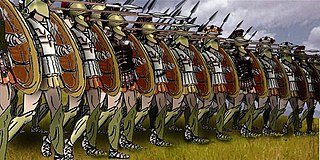
Heavy infantry consisted of heavily armed and armoured infantrymen who were trained to mount frontal assaults and/or anchor the defensive center of a battle line. This differentiated them from light infantry who were relatively mobile and lightly armoured skirmisher troops intended for screening, scouting, and other tactical roles unsuited to soldiers carrying heavier loads. Heavy infantry typically made use of dense battlefield formations, such as shield wall or phalanx, multiplying their effective weight of arms with force concentration.
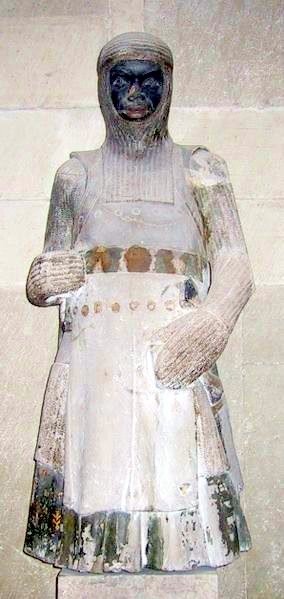
A coat of plates is a form of segmented torso armour consisting of overlapping metal plates riveted inside a cloth or leather garment. The coat of plates is considered part of the era of transitional armour and was normally worn as part of a full knightly harness. The coat saw its introduction in Europe among the warring elite in the 1180s or 1220s and was well established by the 1250s. It was in very common usage by the 1290s. By the 1350s it was universal among infantry militias as well. After about 1340, the plates covering the chest were combined to form an early breastplate, replacing the coat of plates. After 1370, the breastplate covered the entire torso. Different forms of the coat of plates, known as the brigandine and jack of plates, remained in use until the late 16th century.
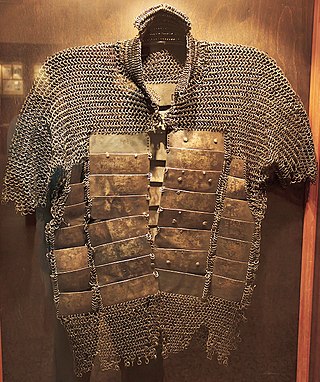
Mail and plate armour is a type of mail with embedded plates. Armour of this type has been used in the Middle East, North Africa, Ottoman Empire, Japan, China, Korea, Vietnam, Central Asia, Greater Iran, India, Eastern Europe, and Nusantara.

Kikko are small iron or hardened leather, hexagon shaped armour plates used in the construction of Japanese armor worn by samurai and ashigaru of feudal Japan.

Tatami (畳具足), or tatami gusoku, was a type of lightweight portable folding Japanese armour worn during the feudal era of Japan by the samurai class and their foot soldiers (ashigaru). The Tatami dō or the tatami katabira were the main components of a full suit of tatami armour.

Illyrian weaponry played an important role in the makeup of Illyrian armies and in conflicts involving the Illyrians. Of all the ancients sources the most important and abundant writings are those of Ennius, a Roman poet of Messapian origin. Weapons of all sorts were also placed intact in the graves of Illyrian warriors and provide a detailed picture for archaeologists on the distribution and development of Illyrian weaponry.
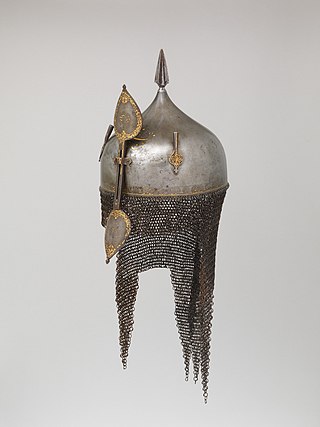
Kulah Khuds were used in ancient western Asia for battle and as decorative head pieces.

Armour in the 18th century was minimalist and restricted almost entirely to cavalry, primarily to cuirassiers and, to a lesser degree, carabiniers and dragoons. Armour had been in rapid decline since the Thirty Years' War, although some archaisms had lingered on into the early years of the 18th century, like Austrian cuirassiers with buff coats and lobster-tailed helmets or Hungarian warriors with mail armour and shields. With the exception of Poland-Lithuania, which still made use of hussars wearing suits of plate armour, armour in Europe was primarily restricted to a breast- and backplate, the cuirass, and a simple iron skull cap worn under the hat. By the later 18th century, there were two contradicting developments. Many cuirassier regiments were discarding their cuirasses, while helmets in the form of so-called dragoon helmets, made of brass or leather, made a comeback among the cavalry and infantry.